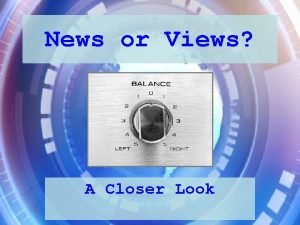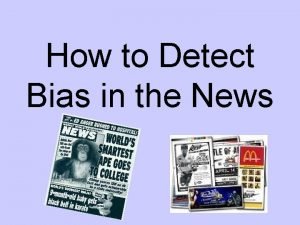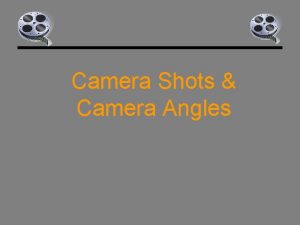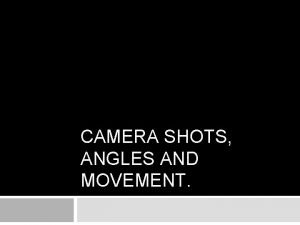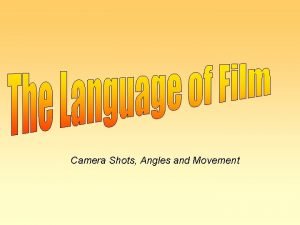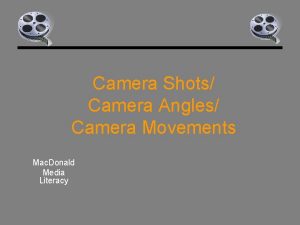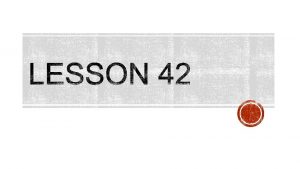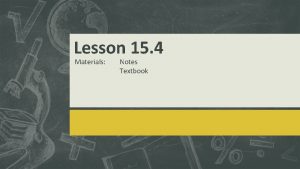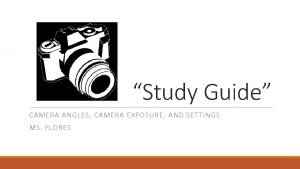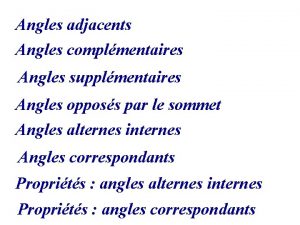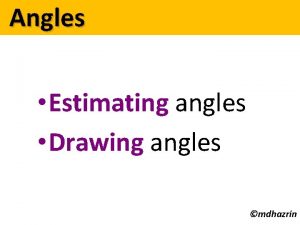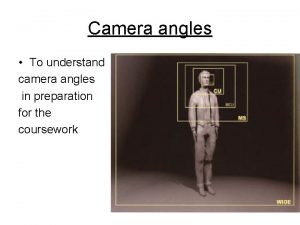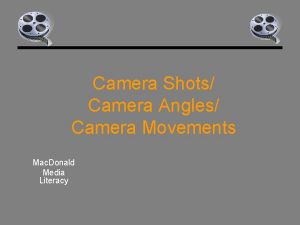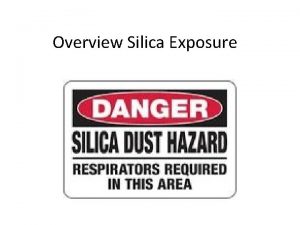Study Guide CAMERA ANGLES CAMERA EXPOSURE AND SETTINGS












- Slides: 12

“Study Guide” CAMERA ANGLES, CAMERA EXPOSURE, AND SETTINGS MS. FLORES

Answer the following questions in your notebook… 1. What camera angle would you use if you want to make your subject appear taller or powerful? Low Angle 2. What camera angle would you use to make your subject appear smaller or vulnerable? High Angle 3. What camera angle would you use to create a little more excitement or sense of activity in the photo? Tilted Angle 4. What camera angle would you use to show the lay out of a place or placement of various subjects/objects? Bird’s Eye View 5. What camera angle would you use to create a fairly neutral photo without any dramatic effect? Eye Level Shot 6. What are some situations in which you might want to try a ground level shot? (Open ended answer could include taking picture of shoes, puppies, or crawling babies-to produce a new perspective)

Name that camera angle! 7. Ground Level

Name that camera angle! High Angle 8.

Name that camera angle! Eye Level 9.

Name that camera angle! Bird’s Eye View 10.

Name that camera angle! Low Angle 11.

Part 2: Camera Exposure and Settings 12. You want to take a portrait of your friend but you want to blur the background as much as possible. Which of the following aperture f-stops should you pick for the most blur? A. f/3. 0 B. f/8. 0 C. f/10. 0 D. f/22. 0 13. Using the same options above, which aperture f-stop would let the least amount of light through the lens? D.

Part 2: Camera Exposure and Settings, continued… 13. If you’re taking photos of your friends dancing and want to freeze the action with no blur, which of the following shutter speeds would you use? A. 1/30 second B. 1 second C. 1/100 second D. 1/800 second 14. Using the same shutter speeds above, which would you choose if you wanted to capture a waterfall in a way that it looks more flowy, smooth, and silky? B.

Part 2: Camera Exposure and Settings, continued… 15. Which of the following best describes the depth of field of the photo and the aperture f-stop that was most likely used? A. Shallow depth of field with f/16 aperture B. Great depth of field with f/2 aperture C. Great depth of field with f/16 aperture D. Shallow depth of field with f/2 aperture

Part 2: Camera Exposure and Settings, continued… 16. Which of the following describes the shutter speed likely used for this photo? A. 2 seconds B. 1/30 second C. 1/1000 second D. 1/100 second

More Camera Exposure! 21. In photography, what is exposure? How light or dark an image will appear 22. What does it mean to over expose and under expose a photograph? Over=too bright, under=too dark 23. How many camera settings affect the exposure and what are they? 3=aperture, shutter speed, and ISO 24. ISO is how sensitive the camera’s _______ is to light. sensor 25. When shooting on a very bright day at the beach or at a snowy mountain landscape, you should use a _________ ISO. (Lower or higher? ) 26. When shooting in a dimly lit room you should use a _______ ISO. (Lower or higher? ) 27. Why is a lower ISO almost always desirable? Higher ISO results in more grain in the photo 28. In photography, what does “high noise” refer to? Refers to a lot of grain in the photo
 Vertical
Vertical Managing economic exposure and translation exposure
Managing economic exposure and translation exposure Transaction exposure and economic exposure
Transaction exposure and economic exposure Managing economic exposure and translation exposure
Managing economic exposure and translation exposure Operating exposure
Operating exposure Bias through statistics and crowd counts examples
Bias through statistics and crowd counts examples Examples of bias through statistics and crowd counts
Examples of bias through statistics and crowd counts Camera shots and angles quiz
Camera shots and angles quiz Camera angle
Camera angle Shot types
Shot types Long shot angle
Long shot angle Bias through selection and omission guiding questions
Bias through selection and omission guiding questions Segment relationships in circles lesson 15-4
Segment relationships in circles lesson 15-4





